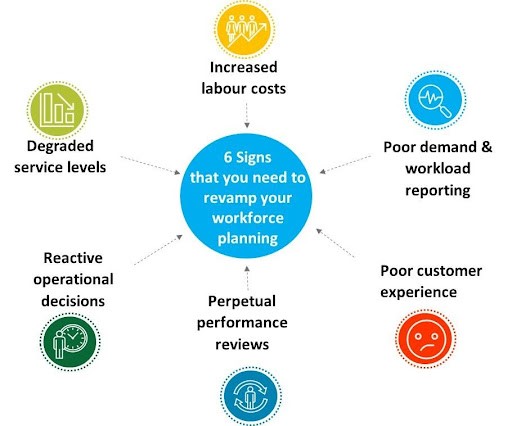Workforce Management is a critical element in managing any contact centre. It ensures the right people are allocated to the right channel at the right time to meet customer demand. While most organisations we work with have a workforce plan, there are often signs that it is not delivering on expectations – leading to both agents and customers suffering. Below are 6 key signs that indicate you need to review your workforce planning:

Degraded service levels
The most obvious and easily identifiable sign that you need to review your workforce planning is degraded service levels. If your contact centre is struggling to meet the current demand, your customers will be facing long wait times, and your agents will feel pressured and overworked. In some instances, we find one channel is achieving or, in some cases, overachieving, whilst others struggle. Worse yet, your overall volumes may not have increased, yet service levels are falling – and you might not know why.
Increased labour costs
You may find that demand has increased a little, but your labour costs are increasing at a much faster rate, and you are only just managing to meet demand. The question is, why? Are resources being allocated where they need to be? Are particular times of the day over-resourced leading to unnecessary costs? Do you have the right mix of part-time and full-time staff to deliver the most effective cost model based on your demand profiles? Are you constantly using overtime to fill gaps in your resourcing? Effective workforce planning is THE most important tool to help you deliver a cost-effective service and maintain a competitive advantage – and it needs urgent attention if costs are rising unnecessarily.
Little to no demand or workload reporting
The question we hear most often from managers of contact centres is, “why have service levels fallen or what is driving increased demand?” This indicates there is no insight into changes in customer demand or its drivers – a fundamental capability that allows you to plan and manage for the future. Similarly, there is often a lack of understanding of what factors have impacted the outcome. Your plan was solid, yet you don’t have visibility on the elements that may have impacted your ability to meet expected service levels – absenteeism, planned leave, product changes, system outages, and the like. Your contact centre does not operate in a vacuum, and you need robust reporting, not just on-demand but also the internal factors impacting service delivery. Trying to build a workforce plan without effective reporting is like trying to plan blindfolded.
Reactive operational decisions
Contact centres without a robust workforce management plan are constantly making decisions in response to events, focusing on dealing with the symptoms of poor planning instead of fixing the actual problem. Reactive operational decisions include reassigning resources on a day-by-day or even hour-by-hour basis, spending time planning for the next day, trying to pull reports and data together, or calling crisis meetings. These events take time away from other activities and lead to a hectic and difficult working environment, with agents often unhappy with the lack of consistency and outcomes. It is almost certain to lead to inconsistent and missed service levels and a poor customer and agent experience.
Perpetual performance reviews
Do you find that you are constantly undertaking reviews of your contact centre as it is just not delivering on expectations? We often find that at the heart of these reviews is poor workforce management – in particular forecasting and the inability to forward plan for resourcing, recruitment, marketing campaigns, expected growth, and much more. Simply dealing with the current issues means that your contact centre is always in the now and is not part of your strategic plan for the future. If you are completing performance reviews of your contact centre regularly, you need to get back to basics, and workforce planning is one of the key elements you need to review.
Inconsistent or poor customer experience
Poor workforce planning practices lead to poor management of customer demand. Without a doubt, the key impacts will be reduced customer satisfaction and increased complaints. Customers don’t like to wait in queues, be offered a call back that does not eventuate, or wait days or even weeks for an email response. If your customer satisfaction is decreasing and your complaints are increasing, you need to make sure that the very basic element of good service delivery – actually answering and responding to customer enquiries – are in place, and that starts with effective workforce planning.
